HSK之结果补语
汉语语法结果补语

HSK ——补语一一结果补语1.什么是结果补语:结果补语是动作发生后的改变结果(一般结果补语是动词或形容词,由于是“改变结果〞,所以后面经常+“了〞).例:listen 动作——heard 结果Look 动作——sow 结果同样,看(动词)——看+见(结果补语)听(动词)——听+见(结果补语)看到听懂想明白考虑清晰洗干净吃饱修理好记住~~~2. 结构:动+结果补语+(宾语)例:我看清晰了 ,那个人不是小王.我一到公司就看见他了 . 电视机没修理好 .(否认形式:没+动+结果补语)(如果)不写完作业我就不睡觉.(否认形式(假设):(如果)不+动+结果补语)3. 问句:动+结果补语+了+吗?例:你听懂了吗?动+ 结果补语+了+没有?你听懂了没有?动+ 没+动+结果补语?你听没听懂?4 练习题:他的感冒终于治了.——他的感冒终于治好了.(“治〞的结果是“好〞了,只说动作,没有结果,意思不清晰.)写作业完再看电视.——写完作业再看电视. 忙了半天,才准备好着晚饭.——忙了半天,才准备好晚饭. (动词和结果补语中间不能加任何成分,“了〞“过〞“宾语〞在结果补语后)1、等A他取B 了钱跑C商店的时候,商店早就已经关D门了.(到)2、我A 哪知道B 他竟然C 会做D 这种可笑又可气的事啊. (出)3、你怎么才回来A?大家已经在这儿B等了C你们D 了.(一个小时)4、他A 给大家B 说了C 这件事发生D 的经过 . (一遍)5、这次到东北去,刚好A住了三B个C月D.(来)6、今天A 我B 来C 找了你D, 你都不在宿舍. (三趟)7、A如果B在这里住C,房租当然D可以廉价一点儿.(一年)8、为了了学习汉语,了解中国,我们A已经B来C北京D 了.(三年半)9、我听了A 很长时间也B 听C 出来这D 是哪个国家的音乐 . (不)10、同学们上A课记B笔记时应该记C老师黑板上的内容D.(下来)11、人们唱着A,跳着B,气氛很快就C活泼D 了.(起来)12、昨天A我B在房间里找了C钥匙D.(一整天)13、昨天A我又给B妈妈打了C电话D.(一次)14、A我们B已经C没见过D面了.(三年)15 、这个地方A 吵B 不得了, C 咱们D 走吧.(得)I 、董事长早上忽然生病住进了医院,下午的会没有______________ .A 、开好B 、开成C 、成功D 、开完2、我问____ 了这里所有的人, 谁也不知道他去哪儿了.A、全B、都C、遍D、问3、你给我书太厚,一个月恐怕_______ .A、不翻译完B、翻译不完C、翻不译完D、翻译完4、说实话,就是过春节我也不想__________ ,由于我觉得没脸见父母.A、回老家来B、回来老家C、回去老家D、回老家去5、今天,就是在最远的农村,人们也都能看_____________ 电视了.A、见B、过C、得D、上6、这时候他们正在上阅览室课呢,恐怕你们____________ .A、进不去教室B、不能进去教室C、不进教室去D、不能进教室去7、他的包不知道什么时候从自行车上掉 __________ 了.A、下来B、进来C、起来D、上来8、近几年工资虽然增加了不少,但普通家庭还是 _____________ 小汽车.A、买得起B、买不起C、买不来D、买得来9、我站在路边等你时,一个穿红衣服的人从我旁边跑___________ 了.A、回来B、过去C、过来D、上去10、我已经学了三个月书法了, 你看这毛笔字____________ .A、写得好看写不好看B、写得好看不好看C、写得好看写得不好看D、写得好看和不好看II 、每天晚饭后他都要陪妻子 __________ .A、散步一会儿B、散散一会儿步C、散一会儿步D、一会儿散步12 、我喝_______ , 这是啤酒.A、起来B、出来C、出去D、下去13 、这个冬天一场雪也没有下, 让人怎么能够________________ 呢?A、兴奋不起来B、兴奋得起来C、兴奋得上来D、兴奋得过来14、这次考试看着容易,可一做_____________ 就不那么容易了,我差点儿没通过.A、起来B、上来C、出来D、下来15 、请李主任接着讲___ ,讲完大家再讨论 .A、起来B、下来C、下去D、过去16 、目前中国的人口比所有欧洲国家的人口加____________ 还要多得多A、下来B、上来C、出来D、起来17 、他整容以后, 谁也___ .A、认她不出来B、认她出不来C、不认出她来了D、认不出她来了18 、经过医生的努力,他终于从昏迷中醒__________ 了 .A、起来B、回来C、过来D、出来19 、这件衣服看起来挺漂亮的, 你就买__________ 吧.A、出来B、下来C、过去D、下去20、风停了,大海平静了__________ .A、下来B、上来C、起来D、出来21 、你们是不是盼望我再死_________ 一次,那是不可能的.A、过去B、过来C、下来D、起来22、今天的雾太大了, 远处的景物.A、看得见B、看不见C、不看见D、不能看见23 、谢谢你们 ,所有的事情都________ .A、安排好得很B、很安排得好C、安排得很好D、好安排得很24 、这个词的用法, 连好多有经验的老师也说不____________ .A、下来B、起来C、上去D、出来25、你出去的时候,请帮我把这些旧报纸扔________________ .A 、掉B 、下C 、完D 、去26、这是赵工程师设计_______ 的图纸.A、出来B、下来C、起来D、过来27 、我想把我的房子租_______ , 你的同事有没有想租房子的.A、下来B、下去C、出来D、出去28 、你们看,他这么一装扮, 谁还__ 他是谁?A、认不出来B、认得出来C、认不出去D、认得出去。
新HSK语法----可能补语
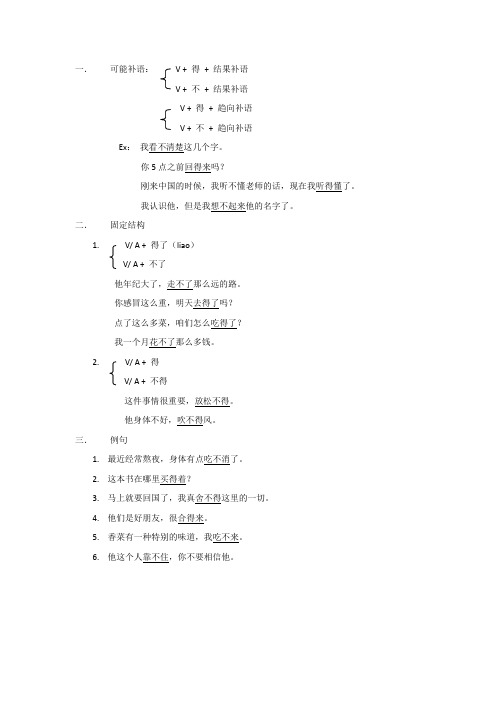
一.可能补语:V + 得+ 结果补语
V + 不+ 结果补语
V + 得+ 趋向补语
V + 不+ 趋向补语
Ex:我看不清楚这几个字。
你5点之前回得来吗?
刚来中国的时候,我听不懂老师的话,现在我听得懂了。
我认识他,但是我想不起来他的名字了。
二.固定结构
1.V/ A + 得了(liao)
V/ A + 不了
他年纪大了,走不了那么远的路。
你感冒这么重,明天去得了吗?
点了这么多菜,咱们怎么吃得了?
我一个月花不了那么多钱。
2.V/ A + 得
V/ A + 不得
这件事情很重要,放松不得。
他身体不好,吹不得风。
三.例句
1.最近经常熬夜,身体有点吃不消了。
2.这本书在哪里买得着?
3.马上就要回国了,我真舍不得这里的一切。
4.他们是好朋友,很合得来。
5.香菜有一种特别的味道,我吃不来。
6.他这个人靠不住,你不要相信他。
第六讲——补语(HSK语法结构)
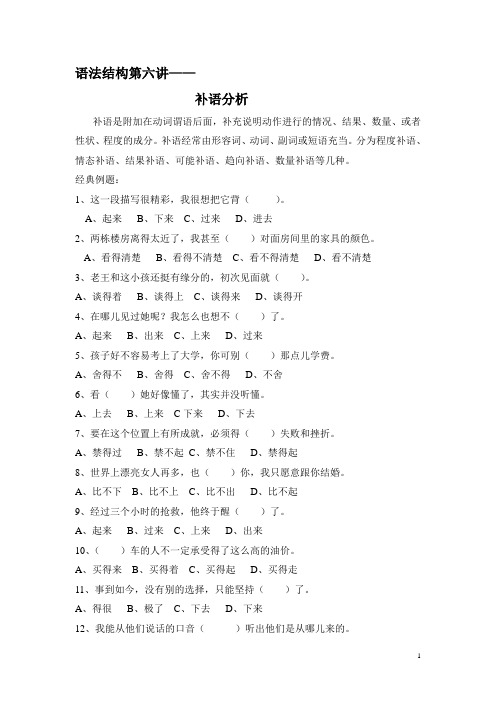
语法结构第六讲——补语分析补语是附加在动词谓语后面,补充说明动作进行的情况、结果、数量、或者性状、程度的成分。
补语经常由形容词、动词、副词或短语充当。
分为程度补语、情态补语、结果补语、可能补语、趋向补语、数量补语等几种。
经典例题:1、这一段描写很精彩,我很想把它背()。
A、起来B、下来C、过来D、进去2、两栋楼房离得太近了,我甚至()对面房间里的家具的颜色。
A、看得清楚B、看得不清楚C、看不得清楚D、看不清楚3、老王和这小孩还挺有缘分的,初次见面就()。
A、谈得着B、谈得上C、谈得来D、谈得开4、在哪儿见过她呢?我怎么也想不()了。
A、起来B、出来C、上来D、过来5、孩子好不容易考上了大学,你可别()那点儿学费。
A、舍得不B、舍得C、舍不得D、不舍6、看()她好像懂了,其实并没听懂。
A、上去B、上来C下来D、下去7、要在这个位置上有所成就,必须得()失败和挫折。
A、禁得过B、禁不起C、禁不住D、禁得起8、世界上漂亮女人再多,也()你,我只愿意跟你结婚。
A、比不下B、比不上C、比不出D、比不起9、经过三个小时的抢救,他终于醒()了。
A、起来B、过来C、上来D、出来10、()车的人不一定承受得了这么高的油价。
A、买得来B、买得着C、买得起D、买得走11、事到如今,没有别的选择,只能坚持()了。
A、得很B、极了C、下去D、下来12、我能从他们说话的口音()听出他们是从哪儿来的。
A、听出B、听见C、听到D、听上13、你已经()了,应该出去散散步了。
A、看了书一整天B、看一整天了书C、看书了一整天D、看了一整天书14、午饭吃得太少了,还没到四点就感觉饿得()。
A、坏了B、死了C、极了D、不得了15、他把搜集来的民间故事整理(),编成了一本民间故事集。
A、上来B、出来C、出去D、下来16、钟楼里传来的钟声()了旧的一年,迎来了崭新的一年。
A、送走B、送来C、送去来D、送上17、他发现高价买回来一批假货,连连抱怨()。
基于HSK动态作文语料库的结果补语“到”的偏误分析
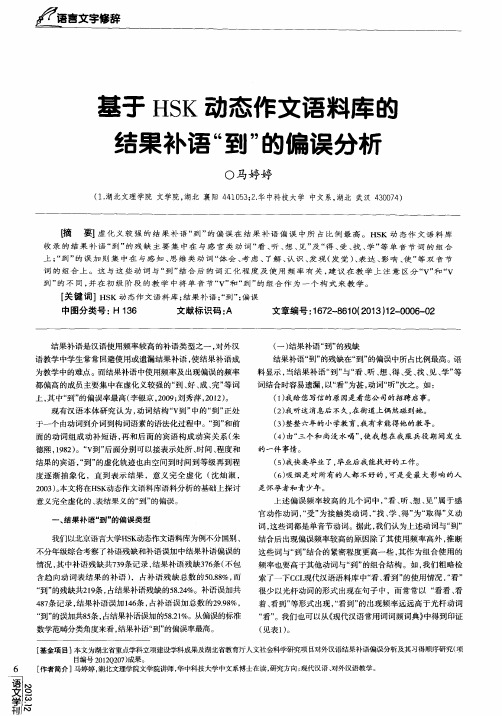
、
结果补语“ 到” 的偏 误 类 型
我们 以北京语言大学H s K 动态作文语料库为例不分 国别 、 不分年级综合考察 了补语残缺和补语误加 中结果补语偏误 的 情况 , 其中补语 残缺共7 3 9 条记录 , 结果补语残缺3 7 6 条( 不包 含趋 向动词表结果 的补语 ) ,占补语残缺 总数 的5 0 . 8 8 %, 而
“ 到” 的残缺共2 1 9 条, 占结果补语残 缺的5 8 . 2 4 %。补语误加共
4 8 7 条记录 , 结果补语误加 1 4 6 条, 占补 语 误 加 总 数 的2 9 . 9 8 %,
着、 看到” 等形式 出现 , “ 看到 ” 的出现频率远远高于光杆动词 “ 看” 。我们也可以从 《 现代汉语常用词词频词典 》 中得到印证
料显示 , 当结果补语 “ 到” 与“ 看、 听、 想、 得、 受、 找、 见、 学” 等
词结合时容 易遗漏 , 以“ 看” 为甚 , 动词“ 听” 次之。如 :
上, 其 中“ 到” 的偏误率 最高( 李银京 , 2 0 0 9 ; 刘秀萍 , 2 0 1 2 ) 。
现有汉语本体研究 认为 , 动词结构 “ vN” 中的“ 到” 正处 于一个 由动词 到介词到构词语素的语法化过程 中。“ 到” 和前 面 的动词组成 动补短语 , 再和后 面的宾语构成 动宾关 系 ( 朱 德熙 , 1 9 8 2 ) 。“ V 到” 后面分别可以接表示处所 、 时间、 程度和
( 1 ) 我给您写信 的原 因是看您公司的招聘启 事。
( 2 ) 我 听 这 消 息后 不 久 。 在街道上偶然碰到她。
( 3 ) 整整 六年的小学教 育, 我有 幸能得他的教导。
( 4 ) 由“ 三个和 尚没水喝 ” , 使 我 想 在 我 服 兵 役 期 间发 生 的 一件 事情 。
Грамматика HSK 5 结果补语

Грамматика HSK 5结果补语jiéguǒ bǔyǔ дополнение (комлемент) результата结果补语- это дополнение (комплемент), которыйупотребляется после сказуемого (谓语), выраженного глаголом, иуказывает на результат действия. Образуется путем прямогоприсоединения к глаголу одной из результативных морфем (вараженной глаголом или прилагательным), характеризующих итог действия.动词:打开了(dǎ kāi leоткрыть)救活了(jiù huó le спасти от смерти) 记住了(jìzhùle запомнить) 打碎了(dǎ suì leразбить) 学会了(xué huì le выучить)形容词:吃饱了(chī bǎo le наесться) 喝足了(hē zú leнапиться) 睡好了(shuì hǎo le выспаться) 玩腻了(wán nì le наиграться) 听清楚了(tīng qīng chǔ leрасслышать)Как образуется结果补语? Действие → результат.→ 他摔倒了。
Он упал.;tā dǎo le → tā shuāi dǎo le。
救他了;他活了→ 他被救活了。
Он былспасѐн.jiù tā le ;tā huó le → tā bèi jiù huó le。
对外汉语教学之结果补语讲解(西安语风汉教中心)

对外汉语教学之结果补语讲解(西安语风汉教中心)第一篇:对外汉语教学之结果补语讲解(西安语风汉教中心) 对外汉语教学之结果补语讲解(西安语风汉教中心)根据西安语风汉语教育培训中心的观察结果补语是众多外国学生学习汉语的难点之一,一个重要原因就是汉语中结果补语数量较多,又不像别的语法点那样有很强的规律性,在教学中只能是随文教授。
在教学中可以采用分解教学的方法来进行讲解,比如:我看生词。
我懂了。
——我看懂了生词。
我听录音。
我懂了。
——我听懂了录音。
我洗衣服。
衣服干净了。
——我洗干净了衣服。
我做作业。
作业完了。
——我做完了作业。
对外汉语老师可以尝试着用这样的方式在课堂上进行讲解,然后通过句型变换、选词填空等练习方式进行巩固,相信学生通过反复的训练,就可以很快掌握这个重要的汉语知识点。
第二篇:西安语风汉教中心汉语学习趣事西安语风汉教中心汉语学习趣事在西安语风汉语教学培训中心外国人学习汉语的过程中,经常会闹出一些好玩的事情。
我以前有个德国学生中文名叫魏星,有一天他去公安局登记信息。
民警问:“您贵姓?”魏星回答:“我姓魏。
”民警又问:“为什么?”魏星听了一头雾水,问:“为什么?姓魏也要问为什么?”民警一听就知道误会了,后来手脚并用才解释清楚。
还有一个事情,是发生在我读研究生的时候。
我带了一个零起点的大班,课堂妙趣横生。
刚开学没几天,学生学了“你叫什么名字?”,学生互相问答。
来自西班牙的劳拉因为紧张,一开口说成了“我叫什么名字?”其他同学愣了一会后,齐齐回答:“你叫劳拉。
”然后全班都大笑。
事实上,老师重在引导学生,即便学生在学习外语时闹出笑话,也是正常的事情,老师引导学生,不要因为犯错误而不敢开口讲话,相反,要鼓励学生大胆开口说,这样语言才会学得好。
第三篇:西安语风汉教中心老外亲历茶文化西安语风汉教中心老外亲历茶文化——西安语风“茶文化”主题活动顺利结束Foreign Friends Experienced Chinese Tea Ceremony Tea culture themed activity held by Xi’an Mandarin Education School endedsmoothly2014年3月23日,由西西安语风汉教中心和真源五维生活艺术馆共同组织的“茶文化”活动拉开帷幕。
HSK6考点

新 HSK 六级汉语水平语法知识点归纳1. 一般名词:妈妈教室词典自行车水平精神2. 方位名词:里外上下前后中左右东西南北复合方位名词: 里边外边上边下边前边后边旁边中间东边西边南边北边3. 时间名词:年月日星期小时今天去年4. 名词重叠:年年月月天天人人家家1 .人称代词:你(您) 你们我我们他(她) 他们(她们) 咱咱们2 .疑问代词:谁哪哪里(哪儿) 什么怎么怎么样几多少3 .指示代词:这这些那那些这里(这儿) 那里(那儿) 这么那么这样那样4 .其他代词:各每有的有些别人别的它它们1. 一般动词:看写打参观爱想喜欢希望像姓在进行2. 动词重叠:想想看看学习学习研究研究说(一)说试(一)试听了听走了走3. 助动词:能会要想可能可以愿意应该得(dei)1. 一般形容词:大红多错全安静漂亮男女老少2. 形容词重叠:高高长长好好整整齐齐干干净净高高兴兴1. 基数:零 0 一十百千万二两半2. 序数:二年级 331 路 14 楼 6 门 15 号 2 月 5 号第一3 .概数:三四个十几个几十年四十多人两年多两个多小时4 .分数、百分数:三分之二 (2/3) 百分之四十(40%)5 .倍数、小数:五倍七点八(7.8) 三点一四一六(3.1416)1. 名量词:个位本件种斤公斤克间棵课张把只条口米公尺2. 名量词重叠:个个(都不错) 张张(笑脸) 条条(大路) 种种(事情)3. 动量词:次遍回下口1. 否定副词:不没(有) 别2. 时间副词:正刚常常常已经正在总(是) 才(1) 就(1)3. 范围副词:都(1) 只一共4. 程度副词:很太更最十分非常多(么)5. 频度副词:又再还也1. 引出时间、处所、起点:当在从离2. 引出方向:向往朝3. 引出对象:对跟和比为给4. 引出目的、原因:为为了5. 引出施事:把被叫让6. 表示排除和加合:除了…… 除了……以外1. 连接词或词组:和跟或者还是2. 连接分句:虽然但是要是所以可是还是但而且只好1.结构助词:的(1) 地得2. 动态助词:了着过呢3. 语气助词:吗呢吧啊了4. 其他:等啊喂哈哈噼里啪啦呜呜1、联合词组:工厂、商店和学校老师和学生我和他红的和绿的去或者不去2. 偏正词组:大操场英文课本一件衣服努力(地) 工作劳动的时候3. 动宾词组:打电话买东西进教室进行讨论遇到困难4. 动( 形) 补词组:听清楚买不到住几天玩得很高兴好得很漂亮极了5. 主谓词组:腿疼石头冷学习紧张精神愉快6. 介宾词组:在学校(学习) 向前(走) 为大家(服务) 把他(叫来)7. “的”字词组:中文的老师的蓝的用的卖菜的我的1. 名词或名词性词组:我的书漂亮小姐汉语水平一座桥那件2. 动词词组:坐车写完看得懂走出来慢慢说可以看去参观3. 形容词词组:很舒服非常高兴大一点儿容易得很1.名词、代词、数词、名词词组作主语:同学们都到了。
对外汉语初中级(HSK4级)语言点整理

对外汉语初中级(HSK4 级)语言点语法结构(grammar frame):1. ……(time)就要……了;快要……了我明天就要回美国了。
*我明天快要回美国了。
2.从……回到(了)……从……v.到(了)…… (V:回;走;来;拿)学生们从各个地方回到了学校。
3.……离……(不)很远/近张天明的家离学校很远。
4. ……帮……搬…………帮……V……我帮新生搬行李。
5. ……对……有/没有好处运动对身体有好处。
6.……有益于……(……对……有好处)运动有益于身体健康。
(运动对身体健康有好处。
) 7. ……的时候,……我来中国的时候,妈妈给我买了很多衣服。
8.等……(的时候/以后),……等事业真正发展起来了,房子会有的,车子也会有的。
9. 等……才……我等写完功课以后才看电影。
10. 一+V (V:写;吃;听;尝)一+V+就+vp他说外面下雨了,我一看,真的下雨了。
今天的语法很容易,我一听就懂了。
11.又……又……中国菜又好吃又便宜。
12. 少/多+V 点儿(+O)吸烟对身体没有好处,你要少吸点儿烟。
13. 总的来说……总的来说,中国菜是对身体健康有好处的。
14. 一般来说……在美国,一般来说,老师重视自由发展。
15. ……,这就要看……V/adj+不+V/adj+了A:你一个小时可以做完功课吗?B :这就要看功课多不多了。
16.……,就是……这家餐厅的菜很好吃,就是有点儿贵。
17. adj +是+ adj ,就是(可是,不过)……这件衣服漂亮是漂亮,就是太贵了。
18. ……还是……的,就是……这套房子还是比较好的,就是房租有点儿贵。
19. 非……不可……(一定要……)张天明买衣服非名牌不可。
20. 对……来说,……对美国人来说,写汉字很难。
对学校来说,学生的安全最重要。
21. ……,就拿……来说(吧) ,……我觉得在家庭里,男女已经很平等了。
就拿我家来说吧,我爸爸跟妈妈分担家务。
22. ……,像……等等妈妈给他买了几件衣服,像 T 恤衫、毛衣、牛仔裤等等。
hsk级语法盘点

h s k级语法盘点 Revised by Liu Jing on January 12, 2021H S K5级语法盘点一语素(一) 粘着语素1 词头(前缀)253 第(第一、第二、第三……)254 老(老大、老周、老张,老爹,老玉米……)[逗号前为甲、乙两级出现的语素或词语,逗号后为本级出现的语素或词语,以下依此类推.]255 小(小王、小孩儿,小丁、小兰……)256 阿(阿哥、阿妹、阿宝、阿英、阿婶……)257 初(初一、初二、初十……)2词尾(后缀)258 们(我们、他们,公民们、队员们、奴隶们……)259 儿(画儿、玩儿、有点儿,个儿、座儿、冰棍儿、闹着玩儿、走后门儿……)260 头(木头、馒头,后头、前头、里头、外头、拳头、上头……)261 子(本子、叉子,盖子、谷子、钩子、蚊子、柱子、燕子、一下子……)262 家(作家、画家、文学家,歌唱家、舞蹈家……)263 化(恶化、工业化、革命化,水利化、电气化……)264 性(积极性、科学性,传染性、流行性、装饰性……)265 学(教育学、社会学、营养学,心理学、药物学……)266 员(党员、服务员、运动员,保管员、售货员……)267 度(速度、高度、温度、程度,长度……)268 件(条件、文件、事件,零件、证件……)269 式(旧式、新式、男式、女式、闭幕式……)270 物(事物、礼物、动物、植物,读物、农作物、刊物……)271 长(团长校长局长,厂长、秘书长、事务长、参谋长……)272 者(作者、记者、爱好者,申请者、雕刻者……)3 其他273丽(美丽,壮丽……)274 民(人民、民主,公民、民间、民用……)275秘(秘密,秘书……)276 慎(慎重、谨慎……)277 言(语言、寓言、发言,宣言、谣言……)278 语(语调、语文、汉语、英语,俄语……)279 障(保障、障碍……)280 珍(珍珠、珍惜、珍贵……)281 祖(祖国,祖父、祖母、祖先……)(二)自由语素282 光(光辉、光明、光荣、光线、光滑、光临……)283 打(打算、打倒、打针,打败、打击、打架、打量、打仗……)284 加(加工、加强、加以,加紧、加入、加速、加油……)285 高(高大、高原,高等、高级、高压、高潮、高峰、高粱、高尚……)286 优(优点、优良、优美、优秀、优胜、优势、优越……)287 报(日报、汇报、情报、预报/报复、报刊、报社,报仇、报酬……)288 成(变成、完成,达成、构成、形成、赞成、合成、速成、养成、组成……)289 开(离开、公开、展开、召开/开办、开发、开饭、开口、开夜车、开幕……)290 动(带动、开动、流动、震动、振动/动手、动机、动静、动力、动摇……)291 制(编制、复制、公制、研制、抵制/制定、制订、制止、制作……)292 作(操作、写作、制作、协作/作为、作风、作物、作战……)293 地(地图,地板、地理、地质、地势、地毯、地震/土地、田地、大地、殖民地……)294 电(电池、电力、电铃、电炉、电脑、电器/彩电、发电、停电、无线电……)295 流(流动、流传、流水、流行、流氓、流域/交流、轮流、河流、电流……)296 产(产量、产品、产生、产物、产值/生产、增产、破产、财产……)297 平(平常、平等、平均、平静、平凡、平行、平衡/和平、水平……)298 部(教育部、国防部、外交部、俱乐部、编辑部、财政部......)299 车(汽车、卡车、电车、火车、自行车、摩托车......)300 店(商店、书店、饭店、食品店、钥匙店、烤鸭店......)301 馆(宾馆、旅馆、图书馆、体育馆、大使馆、瓷器馆......)302 会(宴会、舞会、晚会、运动会、招待会、辩论会......)303 院(学院、医院、研究院、国务院、科学院、博物院......)304 机(电视机、录音机、洗衣机、计算机、拖拉机、照相机、录相机、摄影机 (305)(春节、劳动节、教师节、儿童节、妇女节,复活节、国庆节、圣诞节……)306 票(车票、电影票、火车票、飞机票,船票、戏票、钞票……)307 园(公园、花园、动物园、植物园、果园、幼儿园、葡萄园……)二词类(一)名词308 人群(书本、车辆、纸张……)309 一带310 上旬(中旬、下旬)(二)动词311 打量312 给予313 给以314 归315 愣316 配317 嫌318 敢于319 便于320 不顾321 惯322 多亏323 不比324 算是325 好比326 总得327 怀328 眼看(三)代词329 彼此330 各自331 某些332 这会儿333 那会儿334 人称代词的活用欢迎大家来我院参观、访问。
新HSK语法----介宾补语

新HSK语法----介宾补语
汉语中的介词短语一般用在动词前面做状语,但是有一小部分也可以用在动词后面做补语,补充说明动作的时间、地点、来源、对象、方向或结果等。
1.动词+ 在/ 到/ 成/ 为+ 宾语
在/到后面一般是时间、地点的词,成/为后面一般是事物。
这件事发生在1980年。
鲁迅先生的故居坐落在一个小胡同内。
他把我送到家。
他每天学习到很晚。
玛丽经常把左读成右。
西湖的风景很漂亮,被人们称为天堂。
2.动词+ 给+宾语
给的后面一般是人,或者是和人有关的地方,如“办公室”“图书馆”。
我的自行车借给朋友了。
这本书明天要还给图书馆。
3.动词+ 向/ 往+宾语
向/往的宾语一般是方向、地点的词,而且一般是国家或地名。
飞机飞往东京。
他被派往灾区。
火车开向南方。
我们走向未来。
4.动词+ 自+宾语
自后面的词一般是时间、地点,常用在书面语。
我来自美国。
这种大米产自东北。
5.动词/形容词+ 于+宾语
于一般用在书面语,表示“在”、“从”、“跟”、“比”、
“对”等。
中华人民共和国成立于1949年。
(在)
他毕业于名牌大学。
(从)
他的年龄相当于我的两倍。
(跟)
今年的物价高于去年。
(比)
运动有利于健康。
(对)。
汉语语法结果补语

汉语语法结果补语集团文件版本号:(M928-T898-M248-WU2669-I2896-DQ586-M1988)HSK——补语——结果补语1.什么是结果补语:结果补语是动作发生后的变化结果(一般结果补语是动词或形容词,因为是“变化结果”,所以后面经常+“了”)。
例:listen动作——heard结果Look 动作——sow 结果同样,看(动词)——看+见(结果补语)听(动词)——听+见(结果补语)看到听懂想明白考虑清楚洗干净吃饱修理好记住~~~2.结构:动+结果补语+(宾语)例:我看清楚了,那个人不是小王。
我一到公司就看见他了。
电视机没修理好。
(否定形式:没+动+结果补语)(如果)不写完作业我就不睡觉。
(否定形式(假设):(如果)不+动+结果补语)3. 问句:动+结果补语+了+吗?例:你听懂了吗?动+结果补语+了+没有?你听懂了没有?动+没+动+结果补语?你听没听懂?4练习题:他的感冒终于治了。
——他的感冒终于治好了。
(“治”的结果是“好”了,只说动作,没有结果,意思不清楚。
)写作业完再看电视。
——写完作业再看电视。
忙了半天,才准备好着晚饭。
——忙了半天,才准备好晚饭。
(动词和结果补语中间不能加任何成分,“了”“过”“宾语”在结果补语后)1、等A他取B了钱跑C商店的时候,商店早就已经关D门了。
(到)2、我A哪知道B他竟然C会做D这种可笑又可气的事啊。
(出)3、你怎么才回来A?大家已经在这儿B等了C你们D了。
(一个小时)4、他A给大家B说了C这件事发生D的经过。
(一遍)5、这次到东北去,刚好A住了三B个C月D。
(来)6、今天A我B来C找了你D,你都不在宿舍。
(三趟)7、A如果B在这里住C,房租当然D可以便宜一点儿。
(一年)8、为了学习汉语,了解中国,我们A已经B来C北京D了。
(三年半)9、我听了A很长时间也B听C出来这D是哪个国家的音乐。
(不)10、同学们上A课记B笔记时应该记C老师黑板上的内容D。
HSK4级语法讲练九 结果补语

第九章结果补语The complement of result一、结果补语的基本特点:说明动作结果的补语,叫作结果补语。
结果补语一般是由动词和形容来充当。
结果补语跟动词或形容词紧密结合,中间不能插入其他成分。
A result complement ,expressed either by a verb or adj.,indicates the result of an action. A verb and its resultant complement are closely linked to each other and do not allow the insertion of another element between them.e.g.•例:listen动作—— heard结果Look 动作—— saw 结果看(动词)——看+见(结果补语)听(动词)——听+见(结果补语)看到听懂想明白考虑清楚洗干净吃饱修理好记住结果补语的结构例如:•形:吃饱了洗干净了听清楚了说对了听错了想明白了修理好了来晚了•动:记住了打碎了学会了看到了睡着放在拿给变成做完对动词及其补语,可以从两个层次上进行理解:吃饱了→我吃饭(我饱了)听清楚了→我听了(内容清楚了)书买到了→买书了(书得到了)•例:我看清楚了,那个人不是小王。
我一到公司就看见他了。
你打错电话了。
这些衣服我已经洗干净了。
•例:电视机没修理好。
我没有看见你的词典。
这道题我没有做对。
(如果)不写完作业我就不睡觉。
(否定形式(假设):(如果)不+动+结果补语)结果补语的结构特点:1、结果补语紧跟在动词、形容词后,动词和补语之间不能插进别的成分。
时态助词也只能放在补语后。
例如:•照完了相(*照相完了)打通电话了(*打是话通了)翻译对一个句子(*翻译一个句子对)打碎了(*打了碎)2、有结果补语的句子常常用来表示动作的完成与实现,补语后常常用“了”,有时根据意义也可以接“过”但是不能接“着”3、有结果补语的句子在时间上表现的是现在以前动作是否完成实现某结果,因此它的否定形式要用“没”。
HSK-5级考试技巧
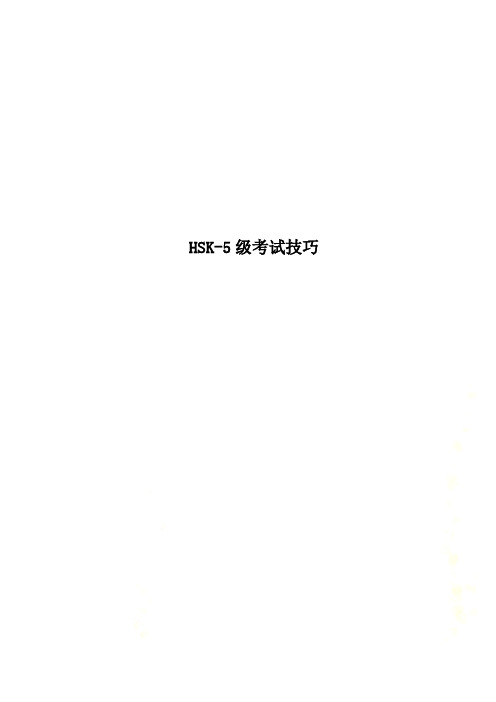
HSK-5级考试技巧HSK 5级考试内容•HSK(五级)共100题,分听力、阅读、书写三部分。
•全部考试约125分钟(含考生填写个人信息时间5分钟)。
考试内容试题数量(个)考试时间(分钟)一、听力第一部分2045 约30 第二部分25二、阅读第一部分1545 40 第二部分10第三部分20三、书写第一部分810 40 第二部分 2填写答题卡10共计/ 100 约120考点与难点•(一)根据上下文的意思选择词语和句子(7/15)•(二)词语搭配(4/15)•(三)词形相似的和词义相近的辨析选择(3/15)•(四)关联词的选择(1 /15)有一位皇帝特别爱骑马,愿意出一千两黄金购买一天能跑一千里的好马,然而时间过去了三年,始终没能买到,又过去了三个月,好不49 发现了一匹千里马,当皇帝派人带着大量黄金去买的时候,马已经死了。
谁都没想到的是,被派出去买马的人居然用五百两黄金把千里马的骨头买了回来。
皇帝生气地说:“你为什么要50 我的黄金?我要的是活马,你怎么花这么多钱弄一匹死马来呢?”这人回答道:“这样别人肯定会想:死马都舍得花五百两黄金买,51 我们的这一52 必然会引来天下人为你提供千里马。
”果然,没过几天,就有人送来了三匹千里马。
49. A 困难 B 容易 C 高兴 D 宝贵(搭配)50. A 罚 B 换 C 破坏нарушать D浪费зря тратить (上下文)51. A 更何况тем более活马呢? B 真是有钱!C 究竟有什么用呢?D 有必要吗?52. A 动作 B 观点 C 行动 D 借口повод (词义相近的辨析)在词语填空中,常常能见到几个词表面很像,都有一个一样的字,意思可能相近也有可能不同。
常见错误:1.看到词形相似的词,虽然意思很不一样,但感到差不多,没有仔细比较,甚至没看清楚就随便选一个。
2.平常记生词时只是大概知道某个词在自己的母语里是什常见错误:在遇到关联词时,只看这个词放进句子里能不能说得通,不注意前后词句的关系,或者只看后面一句,不注意全文的关系。
HSK二级语法总结

第一课词语重叠1、动词单音节动词:A AA\A一A A了A看看看\看一看看了看双音节动词:AB ABAB AB了AB注意:1、只用于经常发生、已经完成或将要发生的行为活动。
不能用在正在进行的句子里。
2、表示动作行为(看、听、说)和思维活动(想、考虑)的两类词,其他动词(如通过、反对)不能重叠3、重叠动词后不加数量、结果等补语。
2、名词汉语少数单音节名词可以重叠,表示全体、所有、每一个AA: 所有的A人人:所有的人年年家家注意:1、重叠后可作主语或状语。
2、有这样词的句子的谓语前一般有“都”。
3、形容词有些形容词可以重叠使用,一般表示程度加深。
单音节形容词: A AA高、好高高、好好一般双音节形容词:AB AABB高兴、整齐高高兴兴、整整齐齐复合形容词:AB ABAB雪白、通红雪白雪白、通红通红注意:1、形容词重叠后已经表示程度加深,不可在其前加“很、大”;2、有的形容词兼属动词,作为动词使用时,动按词的重叠方式重叠。
例如:高兴——高兴高兴,干净——干净干净;4、量词单音节量词一般可以重叠,表示“全部,所有,每一个”的意思。
AA: 所有A个个:全部注意:有这样词的句子的谓语前一般有“都”。
5:数量短语的重叠数量短语在句中也可重叠使用,意义:表示很多、动作的方式、动作的顺序、动作连续发生、动作次数多等。
ABAB 一个一个、两张两张一BB 一个个、一遍遍一B又一B 一个又一个、一遍又一遍第二课固定格式一、名词\名词短语动词\动词短语+ 之前\之后注意:1、表示某一时间、地点、某一时间的前或后。
2、这种用法多用于书面语。
二、名词\名词短语+ 之上\之下注意:1、表示地位、重要性高于某一事物或低于某一事物。
2、使用时在其前加“在、于”与其配合使用。
三、名词\名词短语动词\动词短语+ (之)中注意:1、一般不用再单音节词后,例如不说“在河之中”。
2、多用于书面语,口语说“.......里”。
四、在+ 名词\名词短语动词\动词短语+ 以前表示比某一时刻早的时间。
结果补语(对外汉语)

wán 完終わるドゥワンdúwán读完読み終えるカンワンkànwán看完見終わるチョンchéng成~になるビエンチョンbiànchéng变成~に変わるイーチョンyìchéng译成訳すジィエンjiàn 见感じ取るカンジィエンkànjiàn看见見えるティンジィエンtīngjiàn听见聞こえるドゥンdǒng懂理解するカンドゥンkàndǒng看懂見て分かるティンドゥンtīngdǒng听懂聞いて分かるダオdào 到達するホゥイダオhuídào回到帰り着くショウダオshōudào收到受け取るヂュzhù住固定するジーヂュjìzhù记住覚えるヂャンヂュzhànzhù站住立ち止まるザイzài在落ち着くジュザイzhùzài住在住むヅゥオザイzuòzài坐在座るゲイgěi给与えるジエゲイjiègěi借给貸すスンゲイsònggěi送给送るヂャオzháo着結果が生じる、目的を達成するシュイヂャオshuìzháo睡着眠るダーヂャオdǎzháo打着命中するホゥイhuì会できるシュエホゥイxuéhuì学会身に付くカイkāi 开開けるダカイdǎkāi打开ほどくゾウzǒu走離れるダイゾウdàizǒu带走持っていくハオhǎo好~し終えるズオハオzuòhǎo做好作り終えるシエハオxiěhǎo写好書き終えるグアンguāng光~し尽くすユングアンyòngguāng用光使い切るマイグアンmàiguāng卖光売り尽くすチンチュqīngchu 清楚はっきりするシエチンチュxiěqīngchu写清楚はっきり書くジャンチンチュjiǎngqīngchu讲清楚はっきり言うツゥオcuò错間違えるシュオツゥオshuōcuò说错言い間違うダツゥオdǎcuò打错(電話を)掛け間違うグアンguàn 惯慣れるカングアンkànguàn看惯見慣れるチーグアンchīguàn吃惯食べ慣れるレイlèi累疲れるゾウレイzǒulèi走累歩き疲れるバオbǎo饱十分になるホバオhēbǎo喝饱たっぷり飲むガンジンgānjìng干净きれいシィガンジンxǐgānjìng洗干净きれいに洗う結果補語になれる動詞結果補語になれる形容詞。
第六讲——补语(HSK语法结构)

语法结构第六讲——补语分析补语是附加在动词谓语后面,补充说明动作进行的情况、结果、数量、或者性状、程度的成分。
补语经常由形容词、动词、副词或短语充当。
分为程度补语、情态补语、结果补语、可能补语、趋向补语、数量补语等几种。
经典例题:1、这一段描写很精彩,我很想把它背()。
A、起来B、下来C、过来D、进去2、两栋楼房离得太近了,我甚至()对面房间里的家具的颜色。
A、看得清楚B、看得不清楚C、看不得清楚D、看不清楚3、老王和这小孩还挺有缘分的,初次见面就()。
A、谈得着B、谈得上C、谈得来D、谈得开4、在哪儿见过她呢?我怎么也想不()了。
A、起来B、出来C、上来D、过来5、孩子好不容易考上了大学,你可别()那点儿学费。
A、舍得不B、舍得C、舍不得D、不舍6、看()她好像懂了,其实并没听懂。
A、上去B、上来C下来D、下去7、要在这个位置上有所成就,必须得()失败和挫折。
A、禁得过B、禁不起C、禁不住D、禁得起8、世界上漂亮女人再多,也()你,我只愿意跟你结婚。
A、比不下B、比不上C、比不出D、比不起9、经过三个小时的抢救,他终于醒()了。
A、起来B、过来C、上来D、出来10、()车的人不一定承受得了这么高的油价。
A、买得来B、买得着C、买得起D、买得走11、事到如今,没有别的选择,只能坚持()了。
A、得很B、极了C、下去D、下来12、我能从他们说话的口音()听出他们是从哪儿来的。
A、听出B、听见C、听到D、听上13、你已经()了,应该出去散散步了。
A、看了书一整天B、看一整天了书C、看书了一整天D、看了一整天书14、午饭吃得太少了,还没到四点就感觉饿得()。
A、坏了B、死了C、极了D、不得了15、他把搜集来的民间故事整理(),编成了一本民间故事集。
A、上来B、出来C、出去D、下来16、钟楼里传来的钟声()了旧的一年,迎来了崭新的一年。
A、送走B、送来C、送去来D、送上17、他发现高价买回来一批假货,连连抱怨()。
Hsk3 结果补语练习
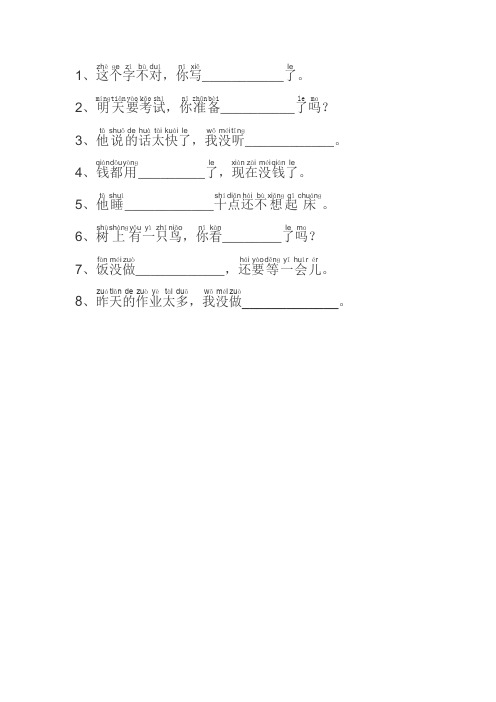
1、这zh è个ɡe 字z ì不b ù对du ì,你n ǐ写xi ě___________了le。
2、明m ín ɡ天ti ān 要y ào 考k ǎo 试sh ì,你n ǐ准zh ǔn 备b èi __________了le 吗m ɑ?3、他t ā说shu ō的de 话hu à太t ài 快ku ài 了le ,我w ǒ没m éi 听t īn ɡ____________。
4、钱qi án 都d ōu 用y òn ɡ_________了le ,现xi àn 在z ài 没m éi 钱qi án 了le 。
5、他t ā睡shu ì____________十sh í点di ǎn 还h ái 不b ù想xi ǎn ɡ起q ǐ床chu án ɡ。
6、树sh ù上sh àn ɡ有y ǒu 一y ì只zh ǐ鸟ni ǎo ,你n ǐ看k àn ________了le 吗m ɑ?7、饭f àn 没m éi 做zu ò____________,还h ái 要y ào 等d ěn ɡ一y ī会hu ìr 儿ér 。
8、昨zu ó天ti ān 的de 作zu ò业y è太t ài 多du ō,我w ǒ没m éi 做zu ò_____________。
1、想学_____汉语,就要常常说汉语。
2、你看____他了吗?3、今天听写,你有两个字写_____了。
4、我已经准备___了,我们走吧。
5、已经十点了,可是我的作业还没写___。
《hsk标准教程》补语语法点编排研究

《hsk标准教程》补语语法点编排研究《HSK标准教程》是一套专门针对汉语水平考试(HSK)的教材。
其中,补语是重要的语法点之一。
本文将从补语的概念、分类以及在《HSK标准教程》中的编排等方面进行研究。
首先,补语是指补充说明主语或宾语的成分,是补充性的、不可缺少的。
常见的补语包括动补、形补和副补。
动补是由动词后面的成分构成,如“他把书读完了”。
形补是由形容词后面的成分构成,如“他把房子打扫得干干净净的”。
副补则是由副词后面的成分构成,如“他把事情做得非常好”。
在《HSK标准教程》中,补语的编排相对集中,同时也分散在各个教材中。
以《HSK标准教程4上》为例,其中第9课《你给我打电话吧》提供了一种动补的使用场景。
通过学习这一课,学生可以掌握使用“把”字句的方式,进而了解动补的用法。
此外,第19课《我跟他谈过》则涉及形补的用法,学生可以通过这一课学习形容词后面的补语。
总的来说,补语在《HSK标准教程》中得到了很好的分布和编排,有利于学生系统地学习和掌握。
此外,在《HSK标准教程》中,补语的学习也与其他语法点相互关联。
例如,在学习补语的同时,学生也会接触到状语、定语等其他语法点,这有助于学生更全面地理解和应用补语。
教材中的例句也经常涵盖多个语法点,帮助学生更好地掌握语言的综合应用能力。
然而,对于某些学生来说,补语的理解和运用可能会存在一定困难。
因此,在教学过程中,教师需要精心设计教学方法和策略,以帮助学生更好地掌握补语的用法。
例如,可以通过分解句子结构,逐步解析补语的语法规则,然后通过练习和实践巩固学习成果。
此外,教师还可以提供一些实际情境的例子,让学生进行模仿和运用,帮助他们更好地理解和记忆。
总结起来,《HSK标准教程》在补语的教学中,相对系统地编排了相关内容,并与其他语法点相互融合,以促进学生的综合语言能力。
然而,教师在教学中仍需要注意学生的理解和掌握情况,采用有效的教学方法和策略,以帮助学生充分掌握补语的用法和应用。
- 1、下载文档前请自行甄别文档内容的完整性,平台不提供额外的编辑、内容补充、找答案等附加服务。
- 2、"仅部分预览"的文档,不可在线预览部分如存在完整性等问题,可反馈申请退款(可完整预览的文档不适用该条件!)。
- 3、如文档侵犯您的权益,请联系客服反馈,我们会尽快为您处理(人工客服工作时间:9:00-18:30)。
jié guǒ bǔ yǔ
结果补语
Result complement
Some verbs or adjectives can be placed after a verb to explain the result of an action.
一、常用动词和结果补语搭配形式(Collocations of common verbs and the result complements)
Tip: Only those verbs or adjectives that can be added to explain the result of an action can serve as result complements.
(一)结果补语为动词(Verbs as result complements)
(二)结果补语为形容词(Adjectives as result complements)
(三)介词(Prepositions)
二、常用格式(Common patterns)
(一)肯定形式(affirmative form)
v. + result complement + ( O ) + (了)Eg:他看见一个苹果。
他说对了。
他听懂了。
妈妈做好饭了。
作业交给老师了。
钱还给同学了。
文章翻译成汉语了。
(二)否定形式(negative form)
没+ v. + result complement + ( O ) Eg:他没听懂老师的话。
我没找着护照。
照片没寄给妈妈。
我们没去成泰国。
名字没写在本上。
三、补充(Supplements)
(一)To change this kind of sentences to interrogatory sentence added “吗”in the end.
(二)没/没有is used in negation, because adding a complement to
a ver
b indicates that the action has completed.不can be
used for negation only when a supposition or
incompletion is indicated.。
